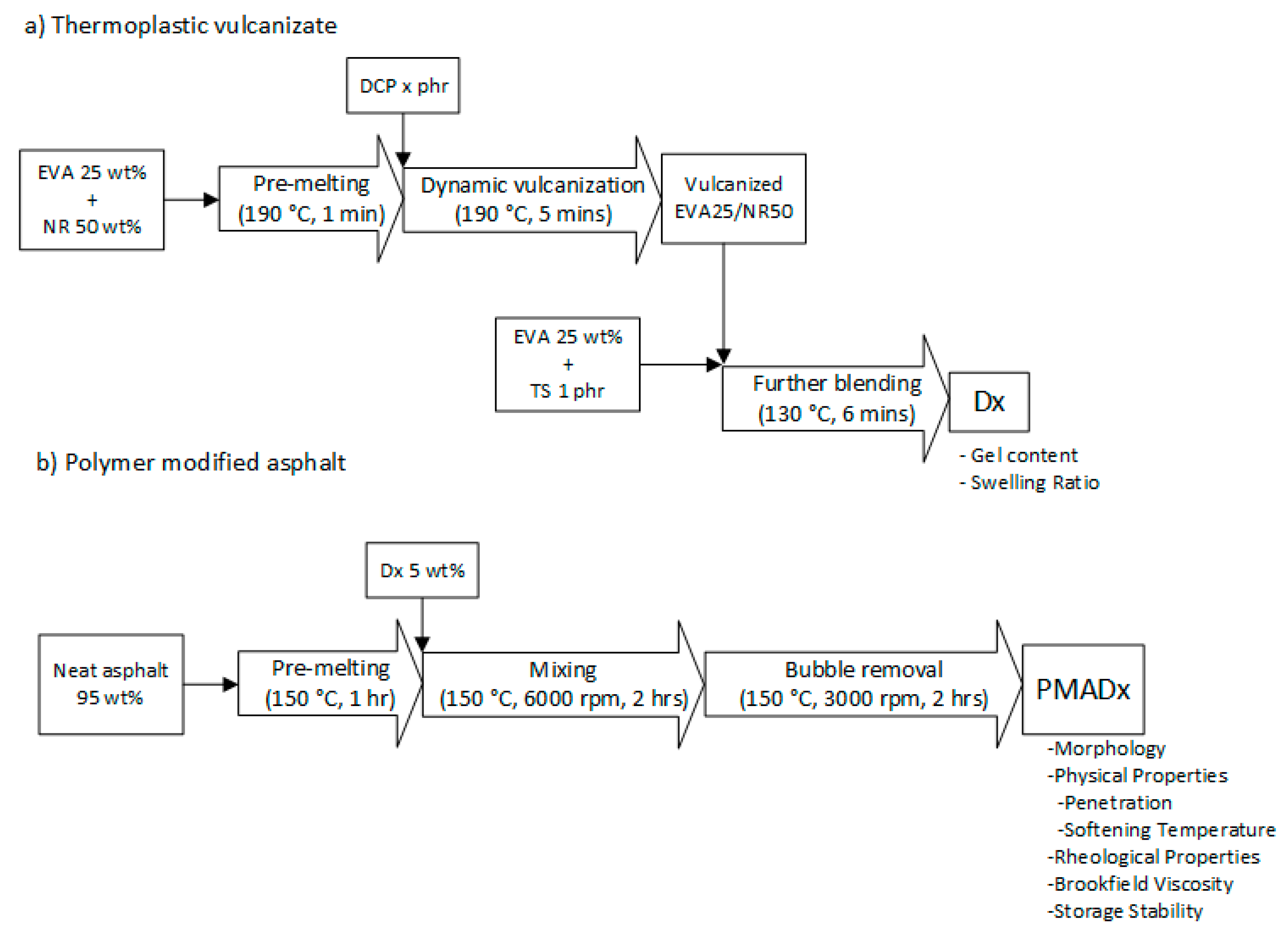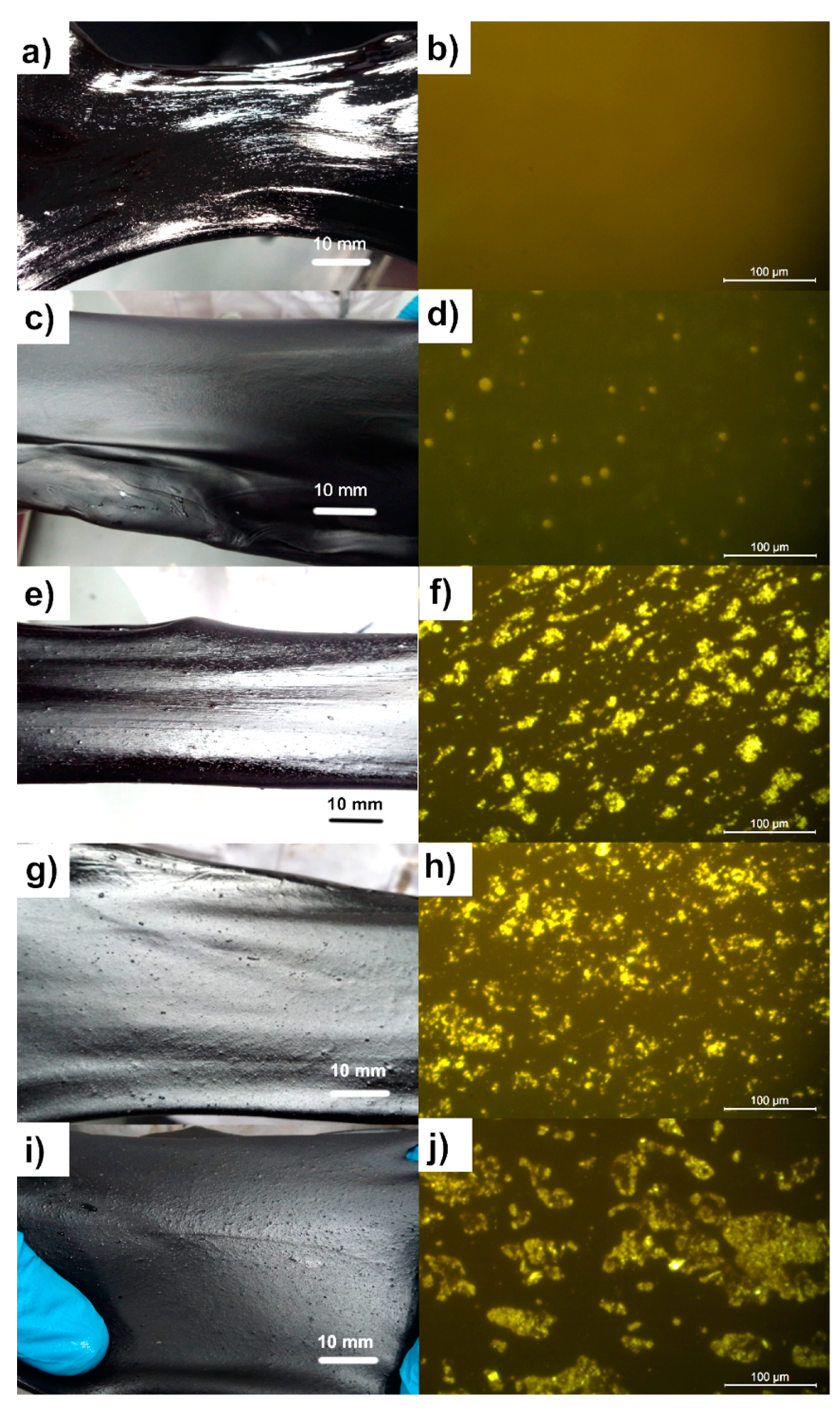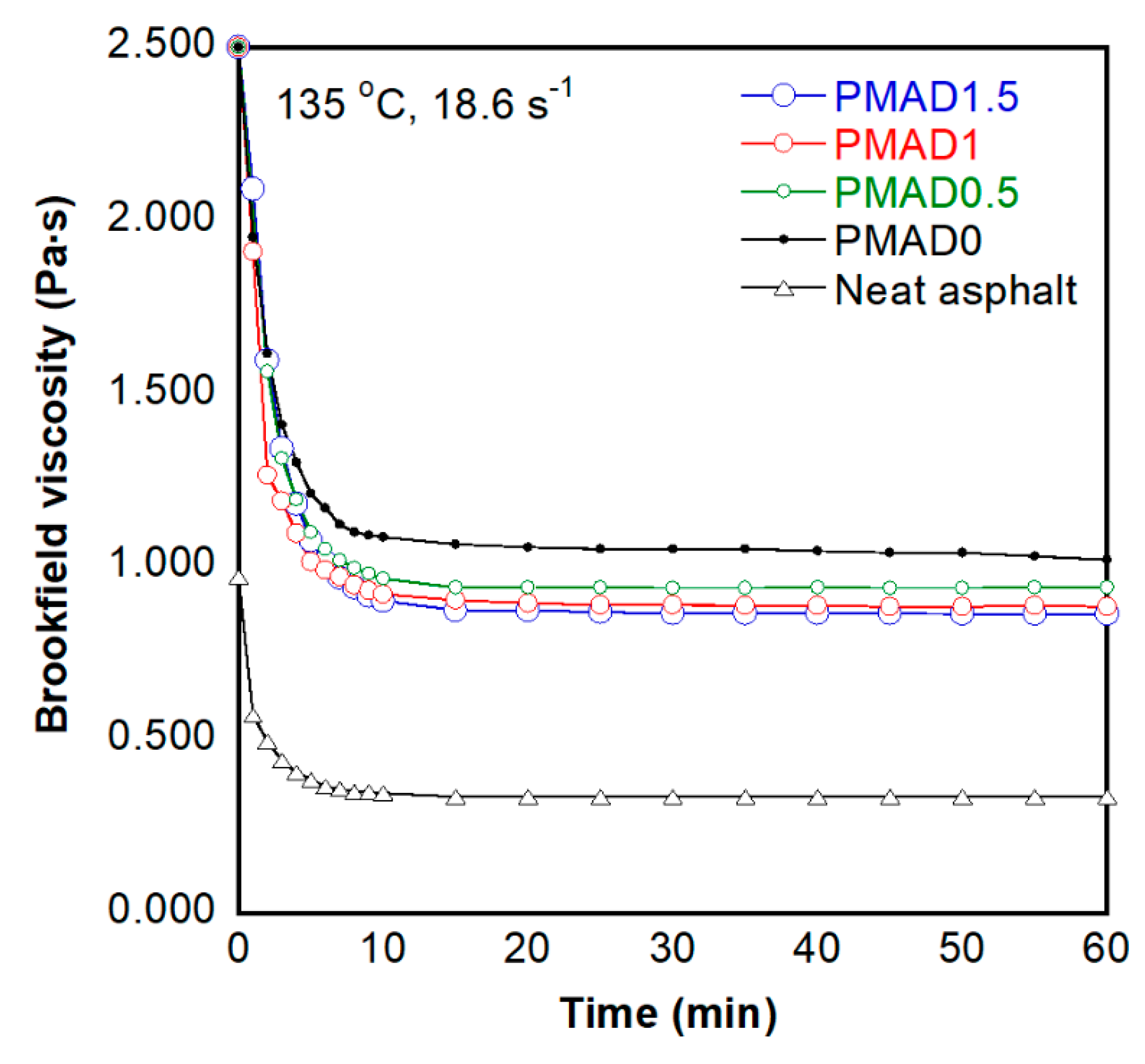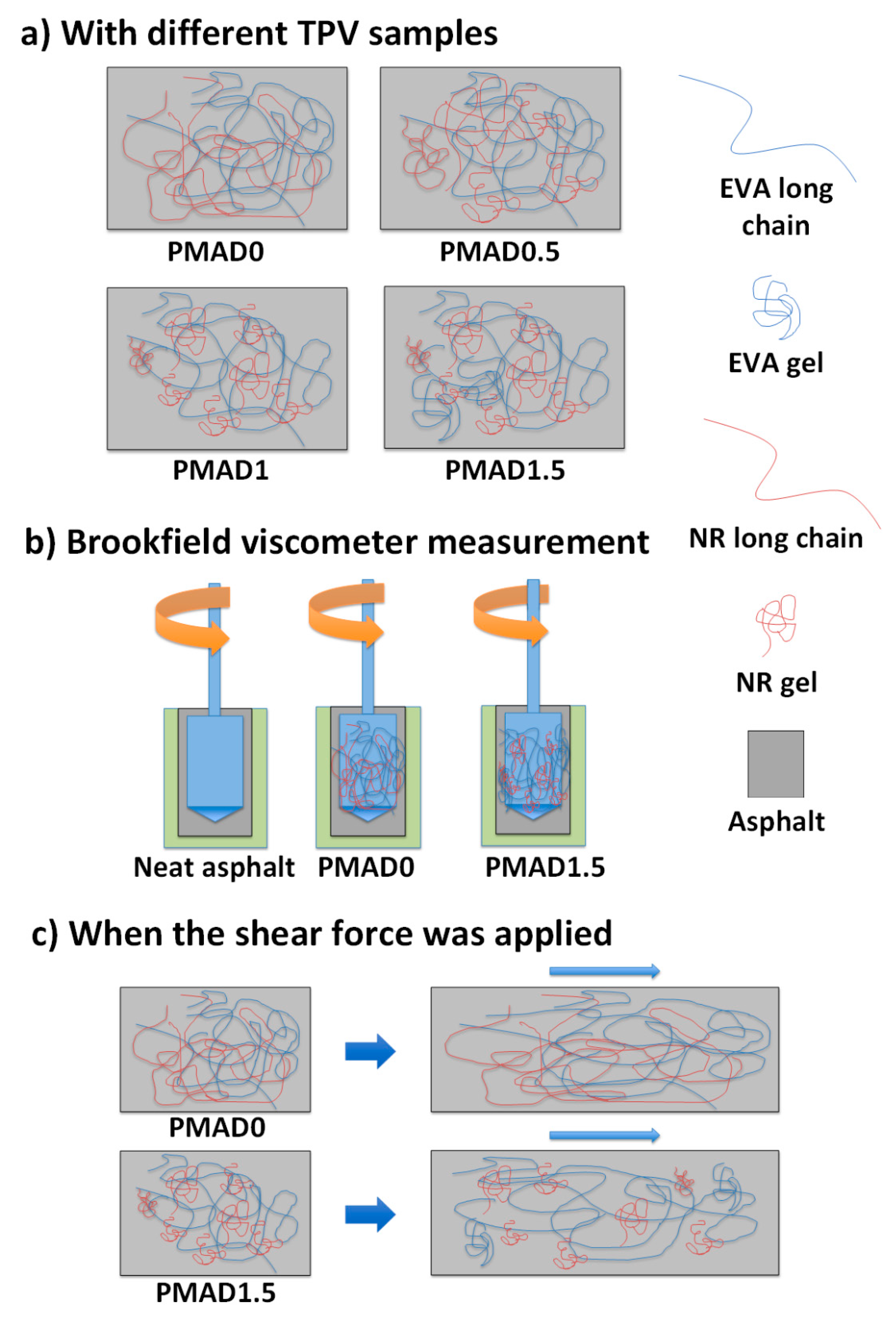Asphalt Incorporation with Ethylene Vinyl Acetate (EVA) Copolymer and Natural Rubber (NR) Thermoplastic Vulcanizates (TPVs): Effects of TPV Gel Content on Physical and Rheological Properties
Abstract
1. Introduction
2. Materials and Methods
2.1. Materials
2.2. Sample Preparation
2.2.1. Preparation of Thermoplastic Vulcanizates (TPVs)
2.2.2. Preparation of Polymer Modified Asphalt (PMA)
2.3. Characterizations
2.3.1. Morphology
2.3.2. Physical Properties
2.3.3. Performance Grading
2.3.4. Rheological Properties
2.3.5. Brookfield Viscosity
2.3.6. Storage Stability
3. Results
3.1. Appearance, Morphology, and Physical Properties
3.2. Performance Grading
3.3. Rheological Properties
3.4. Brookfield Viscosity
3.5. Storage Stability
4. Discussion
5. Conclusions
Supplementary Materials
Author Contributions
Funding
Institutional Review Board Statement
Informed Consent Statement
Data Availability Statement
Acknowledgments
Conflicts of Interest
References
- Science History Institute. History and Future of Plastics. Available online: https://www.sciencehistory.org/the-history-and-future-of-plastics#:~:text=In%201907%20Leo%20Baekeland%20invented,the%20rapidly%20electrifying%20United%20States (accessed on 5 April 2021).
- Horodytska, O.; Valdes, F.J.; Fullana, A. Plastic flexible films waste management—A state of art review. Waste Manag. 2018, 77, 413–425. [Google Scholar] [CrossRef]
- Ragaert, K.; Delva, L.; Van Geem, K. Mechanical and chemical recycling of solid plastic waste. Waste Manag. 2017, 69, 24–58. [Google Scholar] [CrossRef] [PubMed]
- Singh, N.; Hui, D.; Singh, R.; Ahuja, I.P.S.; Feo, L.; Fraternali, F. Recycling of plastic solid waste: A state of art review and future applications. Compos. Part B Eng. 2017, 115, 409–422. [Google Scholar] [CrossRef]
- United Nations Environment Programme. From Birth to Ban: A History of the Plastic Shopping Bag. Available online: https://www.unenvironment.org/news-and-stories/story/birth-ban-history-plastic-shopping-bag#:~:text=1965%20%E2%80%93%20The%20one%2Dpiece%20polyethylene,cloth%20and%20plastic%20in%20Europe (accessed on 27 March 2021).
- Jambeck, J.R.; Geyer, R.; Wilcox, C.; Siegler, T.R.; Perryman, M.; Andrady, A.; Narayan, R.; Law, K.L. Plastic waste inputs from land into the ocean. Science 2015, 347, 768. [Google Scholar] [CrossRef] [PubMed]
- Gerritse, J.; Leslie, H.A.; de Tender, C.A.; Devriese, L.I.; Vethaak, A.D. Fragmentation of plastic objects in a laboratory seawater microcosm. Sci. Rep. 2020, 10, 10945. [Google Scholar] [CrossRef] [PubMed]
- Miao, Y.; von Jouanne, A.; Yokochi, A. Current Technologies in Depolymerization Process and the Road Ahead. Polymers 2021, 13, 449. [Google Scholar] [CrossRef] [PubMed]
- Wichai-utcha, N.; Chavalparit, O. 3Rs Policy and plastic waste management in Thailand. J. Mater. Cycles Waste Manag. 2018, 21, 10–22. [Google Scholar] [CrossRef]
- Chotthong, B. Public-Private-People Partnerships on Plastic Waste Management in Thailand. Available online: http://eascongress2018.pemsea.org/wp-content/uploads/2018/12/S2.3-10-Public-Private-People-Partnerships-on-Plastic-Waste-Management-in-Thailand_BChotthong.pdf (accessed on 20 February 2020).
- Yan, K.; Chen, J.; You, L.; Tian, S. Characteristics of compound asphalt modified by waste tire rubber (WTR) and ethylene vinyl acetate (EVA): Conventional, rheological, and microstructural properties. J. Clean. Prod. 2020, 258, 120723. [Google Scholar] [CrossRef]
- Dalhat, M.A.; Al-Abdul Wahhab, H.I. Performance of recycled plastic waste modified asphalt binder in Saudi Arabia. Int. J. Pavement Eng. 2017, 18, 349–357. [Google Scholar] [CrossRef]
- Dow. Recycled Polymer Modified Asphalt. Available online: https://www.dow.com/en-us/market/mkt-building-construction/sub-build-construction-chem/app-build-constchem-asphalt-modification/recycled-polymer-modified-asphalt.html (accessed on 1 August 2020).
- Lo Presti, D. Recycled Tyre Rubber Modified Bitumens for road asphalt mixtures: A literature review. Constr. Build. Mater. 2013, 49, 863–881. [Google Scholar] [CrossRef]
- Almeida e Silva, J.D.A.; Rodrigues, J.K.G.; de Carvalho, M.W.; Lucena, L.C.F.L.; Cavalcante, E.H. Rheological evaluation of binder modified with micronized polyethylene terephthalate (PET). Rev. Mater. 2018, 23. [Google Scholar] [CrossRef]
- Padhan, R.K.; Mohanta, C.; Sreeram, A.; Gupta, A. Rheological evaluation of bitumen modified using antistripping additives synthesised from waste polyethylene terephthalate (PET). Int. J. Pavement Eng. 2018, 21, 1083–1091. [Google Scholar] [CrossRef]
- Dalhat, M.A.; Adesina, A.Y. Utilization of micronized recycled polyethylene waste to improve the hydrophobicity of asphalt surfaces. Constr. Build. Mater. 2020, 240, 117966. [Google Scholar] [CrossRef]
- Porto, M.; Caputo, P.; Loise, V.; Eskandarsefat, S.; Teltayev, B.; Oliviero Rossi, C. Bitumen and Bitumen Modification: A Review on Latest Advances. Appl. Sci. 2019, 9, 742. [Google Scholar] [CrossRef]
- Liang, M.; Xin, X.; Fan, W.; Wang, H.; Jiang, H.; Zhang, J.; Yao, Z. Phase behavior and hot storage characteristics of asphalt modified with various polyethylene: Experimental and numerical characterizations. Constr. Build. Mater. 2019, 203, 608–620. [Google Scholar] [CrossRef]
- Okhotnikova, E.S.; Frolov, I.N.; Ganeeva, Y.M.; Firsin, A.A.; Yusupova, T.N. Rheological behavior of recycled polyethylene modified bitumens. Pet. Sci. Technol. 2019, 37, 1136–1142. [Google Scholar] [CrossRef]
- Vamegh, M.; Ameri, M.; Chavoshian Naeni, S.F. Experimental investigation of effect of PP/SBR polymer blends on the moisture resistance and rutting performance of asphalt mixtures. Constr. Build. Mater. 2020, 253, 119197. [Google Scholar] [CrossRef]
- Ahmadinia, E.; Zargar, M.; Karim, M.R.; Abdelaziz, M.; Ahmadinia, E. Performance evaluation of utilization of waste Polyethylene Terephthalate (PET) in stone mastic asphalt. Constr. Build. Mater. 2012, 36, 984–989. [Google Scholar] [CrossRef]
- Qian, C.; Fan, W.; Liang, M.; He, Y.; Ren, S.; Lv, X.; Nan, G.; Luo, H. Rheological properties, storage stability and morphology of CR/SBS composite modified asphalt by high-cured method. Constr. Build. Mater. 2018, 193, 312–322. [Google Scholar] [CrossRef]
- Rasool, R.t.; Song, P.; Wang, S. Thermal analysis on the interactions among asphalt modified with SBS and different degraded tire rubber. Constr. Build. Mater. 2018, 182, 134–143. [Google Scholar] [CrossRef]
- Qian, C.; Fan, W. Evaluation and characterization of properties of crumb rubber/SBS modified asphalt. Mater. Chem. Phys. 2020, 253, 123319. [Google Scholar] [CrossRef]
- Islam, S.S.; Singh, S.K.; Ransinchung, G.D.; Ravindranath, S.S. Effect of property deterioration in SBS modified binders during storage on the performance of asphalt mix. Constr. Build. Mater. 2021, 272, 121644. [Google Scholar] [CrossRef]
- López-Moro, F.J.; Moro, M.C.; Hernández-Olivares, F.; Witoszek-Schultz, B.; Alonso-Fernández, M. Microscopic analysis of the interaction between crumb rubber and bitumen in asphalt mixtures using the dry process. Constr. Build. Mater. 2013, 48, 691–699. [Google Scholar] [CrossRef]
- Xiao, F.; Yao, S.; Wang, J.; Wei, J.; Amirkhanian, S. Physical and chemical properties of plasma treated crumb rubbers and high temperature characteristics of their rubberised asphalt binders. Road Mater. Pavement Des. 2020, 21, 587–606. [Google Scholar] [CrossRef]
- Favakeh, M.; Bazgir, S.; Karbasi, M. Dynamically vulcanized thermoplastic elastomer nanocomposites based on linear low-density polyethylene/styrene-butadiene rubber/nanoclay/bitumen: Morphology and rheological behavior. Iran. Polym. J. 2020, 29, 209–217. [Google Scholar] [CrossRef]
- Wang, S.; Wang, Q.; Wu, X.; Zhang, Y. Asphalt modified by thermoplastic elastomer based on recycled rubber. Constr. Build. Mater. 2015, 93, 678–684. [Google Scholar] [CrossRef]
- Naskar, K.; Babu, R.R. Thermoplastic Elastomers (TPEs) and Thermoplastic Vulcanizates (TPVs). In Encyclopedia of Polymeric Nanomaterials; Kobayashi, S., Müllen, K., Eds.; Springer: Berlin/Heidelberg, Germany, 2014. [Google Scholar] [CrossRef]
- Ning, N.; Li, S.; Wu, H.; Tian, H.; Yao, P.; Hu, G.-H.; Tian, M.; Zhang, L. Preparation, microstructure, and microstructure-properties relationship of thermoplastic vulcanizates (TPVs): A review. Prog. Polym. Sci. 2018, 79, 61–97. [Google Scholar] [CrossRef]
- Kunanusont, N.; Samthong, C.; Bowen, F.; Yamaguchi, M.; Somwangthanaroj, A. Effect of Mixing Method on Properties of Ethylene Vinyl Acetate Copolymer/Natural Rubber Thermoplastic Vulcanizates. Polymers 2020, 12, 1739. [Google Scholar] [CrossRef] [PubMed]
- ASTM International. Standard Test Methods for Determination of Gel Content and Swell Ratio of Crosslinked Ethylene Plastics; ASTM International: West Conshohocken, PA, USA, 2001; Volume ASTM D2765-01. [Google Scholar]
- Fang, C.; Qiao, X.; Yu, R.; Yu, X.; Liu, J.; Yu, J.; Xia, R. Influence of modification process parameters on the properties of crumb rubber/EVA modified asphalt. J. Appl. Polym. Sci. 2016, 133. [Google Scholar] [CrossRef]
- ASTM International. Standard Test Method for Penetration of Bituminous Materials; ASTM International: West Conshohocken, PA, USA, 2020; Volume ASTM D5/D5M-20. [Google Scholar]
- ASTM International. Standard Test Method for Softening Point of Bitumen (Ring-and-Ball Apparatus); ASTM International: West Conshohocken, PA, USA, 2020; Volume ASTM D6/D36M-20. [Google Scholar]
- ASTM International. Standard Test Method for Determining the Rheological Properties of Asphalt Binder Using a Dynamic Shear Rheometer; ASTM International: West Conshohocken, PA, USA, 2015; Volume ASTM D7175-15. [Google Scholar]
- ASTM International. Standard Practice for Determining the Continuous Grading Temperatures and Continuous Grades for PG Graded Asphalt Binders; ASTM International: West Conshohocken, PA, USA, 2016; Volume ASTM D7643-16. [Google Scholar]
- Saowapark, W.; Jubsilp, C.; Rimdusit, S. Natural rubber latex-modified asphalts for pavement application: Effects of phosphoric acid and sulphur addition. Road Mater. Pavement Des. 2019, 20, 211–224. [Google Scholar] [CrossRef]
- Brovelli, C.; Hilliou, L.; Hemar, Y.; Pais, J.; Pereira, P.; Crispino, M. Rheological characteristics of EVA modified bitumen and their correlations with bitumen concrete properties. Constr. Build. Mater. 2013, 48, 1202–1208. [Google Scholar] [CrossRef]
- Xia, T.; Zhou, L.; Xu, J.; Qin, Y.; Chen, W.; Dai, J. Rheology and thermal stability of polymer modified bitumen with coexistence of amorphous phase and crystalline phase. Constr. Build. Mater. 2018, 178, 272–279. [Google Scholar] [CrossRef]
- ASTM International. Standard Test Method for Viscosity Determination of Asphalt at Elevated Temperatures Using a Rotational Viscometer; ASTM International: West Conshohocken, PA, USA, 2015; Volume ASTM D4402-15. [Google Scholar]
- ASTM International. Standard Practice for Determining the Separation Tendency of Polymer from Polymer-Modified Asphalt; ASTM International: West Conshohocken, PA, USA, 2020; Volume ASTM D7173-20. [Google Scholar]
- Sengoz, B.; Topal, A.; Isikyakar, G. Morphology and image analysis of polymer modified bitumens. Constr. Build. Mater. 2009, 23, 1986–1992. [Google Scholar] [CrossRef]
- Yu, X.; Burnham, N.A.; Granados-Focil, S.; Tao, M. Bitumen’s microstructures are correlated with its bulk thermal and rheological properties. Fuel 2019, 254, 115509. [Google Scholar] [CrossRef]
- Iwamoto, S.; Lee, S.-H.; Endo, T. Relationship between aspect ratio and suspension viscosity of wood cellulose nanofibers. Polym. J. 2013, 46, 73–76. [Google Scholar] [CrossRef]
- Samthong, C.; Seemork, J.; Nobukawa, S.; Yamaguchi, M.; Praserthdam, P.; Somwangthanaroj, A. Morphology, structure, and properties of poly(lactic acid) microporous films containing poly(butylene terephthalate) fine fibers fabricated by biaxial stretching. J. Appl. Polym. Sci. 2015, 132, 41415. [Google Scholar] [CrossRef]






| Properties | Unit | Value | Standard |
|---|---|---|---|
| Ethylene Vinyl Acetate (EVA) Copolymer | |||
| Vinyl acetate content | wt% | 18 | ASTM D5594 |
| Density | g/cm3 | 0.94 | ASTM D1505 |
| Melt flow index (2.16 kg, 190 °C) | g/10 min | 2.3 | ASTM D1238 |
| Melting temperature | °C | 86 | ASTM D3418 |
| Natural Rubber (NR) | |||
| Mooney viscosity (100 °C) | ML(1 + 4) | 59 | ASTM D1646 |
| Density | g/cm3 | 0.90 | ASTM D792 |
| Glass transition temperature | °C | −67 | ASTM E1356 |
| Dicumyl Peroxide (DCP) | |||
| Purity | % | 99.0 | ASTM E755 |
| Active Oxygen | % | 5.9 | ASTM D2180 |
| Half-life temperature | °C | ||
| 10 h | 117 | ||
| 1 h | 137 | ||
| 1 min | 178 | ||
| Asphalt Binder (Penetration Grade, AC 60/70) | |||
| Penetration at 25 °C (100 g, 5 s) | 0.1 mm | 64 | ASTM D5 |
| Ring-and-ball softening temperature | °C | 47 | ASTM D36 |
| Brookfield viscosity at 135 °C Shear rate 18.6 s−1, spindle 21 | cP | 297.5 | ASTM D4402 |
| Pa s | 0.2975 | ||
| |G*|/sin δ (10 rad/s, 12%strain) at | kPa | ASTM D7175 | |
| 58 °C | 3.06 | ||
| 64 °C | 1.29 | ||
| 70 °C | 0.592 | ||
| Fail temperature (at |G*|/sin δ = 1 kPa) | °C | 66.0 |
| Sample Name | Composition | Gel Content (%) | Swelling Ratio (%) | |||
|---|---|---|---|---|---|---|
| EVA (wt%) | NR (wt%) | DCP (* phr) | TS (* phr) | |||
| D0 | 50 | 50 | 0 | 1 | Totally soluble | |
| D0.5 | 50 | 50 | 0.5 | 1 | 23.9 ± 2.9 | 1491.0 ± 45.8 |
| D1 | 50 | 50 | 1 | 1 | 41.7 ± 1.3 | 1133.5 ± 48.9 |
| D1.5 | 50 | 50 | 1.5 | 1 | 42.6 ± 0.6 | 1064.5 ± 16.2 |
| Sample Name | Penetration (0.1 mm) at 25 °C | TRB (°C) | Fail Temperature (°C) | ||||
|---|---|---|---|---|---|---|---|
| 58 °C | 64 °C | 70 °C | 76 °C | ||||
| Neat asphalt | 64 ± 0 | 47.0 ± 0.3 | 3.1 | 1.3 | 0.6 | - | 66.0 |
| PMAD0 | 47 ± 1 | 53.9 ± 0.3 | - | 3.0 | 1.5 | 0.7 | 73.2 |
| PMAD0.5 | 46 ± 1 | 54.5 ± 0.1 | - | 3.1 | 1.5 | 0.7 | 73.4 |
| PMAD1 | 45 ± 1 | 55.8 ± 0.8 | - | 3.2 | 1.6 | 0.7 | 73.6 |
| PMAD1.5 | 41 ± 1 | 54.8 ± 0.4 | - | 3.3 | 1.6 | 0.8 | 73.7 |
| Parameters | Sample | Angular Frequency (rad/s) | |||
|---|---|---|---|---|---|
| ω = 0.1 | ω = 1 | ω = 10 | ω = 100 | ||
| Storage modulus (Pa) | Neat asphalt | 0.020 | 0.599 | 40 | 1180 |
| PMAD0 | 15.8 | 111 | 1220 | 10,500 | |
| PMAD0.5 | 24.7 | 169 | 1490 | 10,900 | |
| PMAD1 | 14.1 | 136 | 1630 | 13,700 | |
| PMAD1.5 | 10.7 | 118 | 1560 | 14,300 | |
| Loss modulus (Pa) | Neat asphalt | 26 | 263 | 2650 | 26,000 |
| PMAD0 | 96.6 | 772 | 6030 | 42,700 | |
| PMAD0.5 | 114 | 856 | 6240 | 43,500 | |
| PMAD1 | 118 | 972 | 7520 | 51,700 | |
| PMAD1.5 | 114 | 976 | 7770 | 54,100 | |
| G*/sin δ (Pa) | Neat asphalt | 26.1 | 263 | 2650 | 26,000 |
| PMAD0 | 99.2 | 788 | 6280 | 45,300 | |
| PMAD0.5 | 120 | 890 | 6590 | 46,200 | |
| PMAD1 | 119 | 991 | 7880 | 55,300 | |
| PMAD1.5 | 115 | 991 | 8080 | 57,900 | |
| Phase angle (degree) | Neat asphalt | 90.0 | 89.9 | 89.1 | 87.4 |
| PMAD0 | 80.7 | 81.8 | 78.6 | 76.2 | |
| PMAD0.5 | 77.8 | 78.8 | 76.6 | 76.0 | |
| PMAD1 | 83.2 | 82.0 | 77.8 | 75.1 | |
| PMAD1.5 | 84.6 | 83.1 | 78.6 | 75.2 | |
| Complex viscosity (Pa·s) | Neat asphalt | 261 | 263 | 265 | 260 |
| PMAD0 | 979 | 780 | 615 | 440 | |
| PMAD0.5 | 1170 | 873 | 641 | 448 | |
| PMAD1 | 1180 | 981 | 770 | 535 | |
| PMAD1.5 | 1140 | 984 | 792 | 559 | |
| Formula | Softening Temperature (°C) | |||
|---|---|---|---|---|
| Original | After Storage at 163 °C for 5 Days | |||
| Top | Bottom | Difference | ||
| Neat asphalt | 47.0 | - | - | - |
| PMAD0 | 53.9 | 55.4 | 53.6 | 1.8 |
| PMAD0.5 | 54.5 | 57.2 | 55.0 | 2.2 |
| PMAD1 | 55.8 | 58.5 | 56.1 | 2.4 |
| PMAD1.5 | 54.8 | 60.8 | 52.1 | 8.7 |
Publisher’s Note: MDPI stays neutral with regard to jurisdictional claims in published maps and institutional affiliations. |
© 2021 by the authors. Licensee MDPI, Basel, Switzerland. This article is an open access article distributed under the terms and conditions of the Creative Commons Attribution (CC BY) license (https://creativecommons.org/licenses/by/4.0/).
Share and Cite
Kunanusont, N.; Sangpetngam, B.; Somwangthanaroj, A. Asphalt Incorporation with Ethylene Vinyl Acetate (EVA) Copolymer and Natural Rubber (NR) Thermoplastic Vulcanizates (TPVs): Effects of TPV Gel Content on Physical and Rheological Properties. Polymers 2021, 13, 1397. https://doi.org/10.3390/polym13091397
Kunanusont N, Sangpetngam B, Somwangthanaroj A. Asphalt Incorporation with Ethylene Vinyl Acetate (EVA) Copolymer and Natural Rubber (NR) Thermoplastic Vulcanizates (TPVs): Effects of TPV Gel Content on Physical and Rheological Properties. Polymers. 2021; 13(9):1397. https://doi.org/10.3390/polym13091397
Chicago/Turabian StyleKunanusont, Nappaphan, Boonchai Sangpetngam, and Anongnat Somwangthanaroj. 2021. "Asphalt Incorporation with Ethylene Vinyl Acetate (EVA) Copolymer and Natural Rubber (NR) Thermoplastic Vulcanizates (TPVs): Effects of TPV Gel Content on Physical and Rheological Properties" Polymers 13, no. 9: 1397. https://doi.org/10.3390/polym13091397
APA StyleKunanusont, N., Sangpetngam, B., & Somwangthanaroj, A. (2021). Asphalt Incorporation with Ethylene Vinyl Acetate (EVA) Copolymer and Natural Rubber (NR) Thermoplastic Vulcanizates (TPVs): Effects of TPV Gel Content on Physical and Rheological Properties. Polymers, 13(9), 1397. https://doi.org/10.3390/polym13091397








